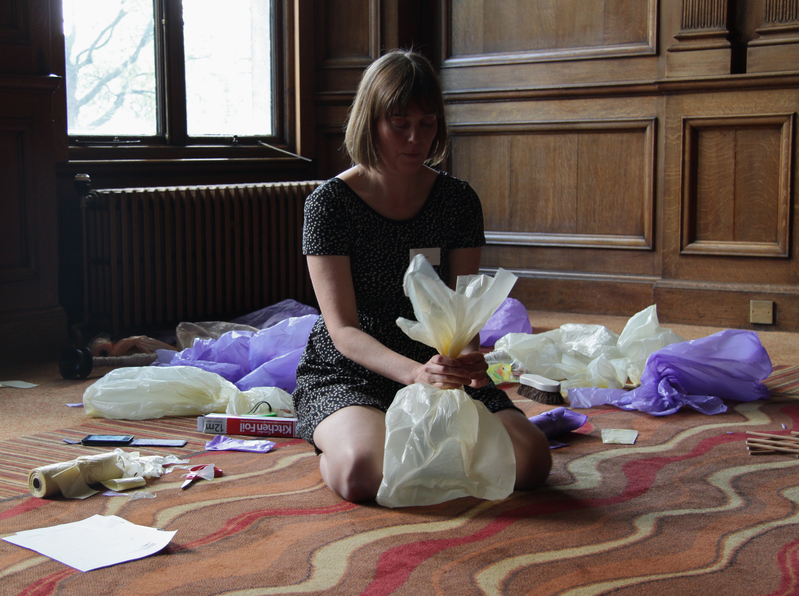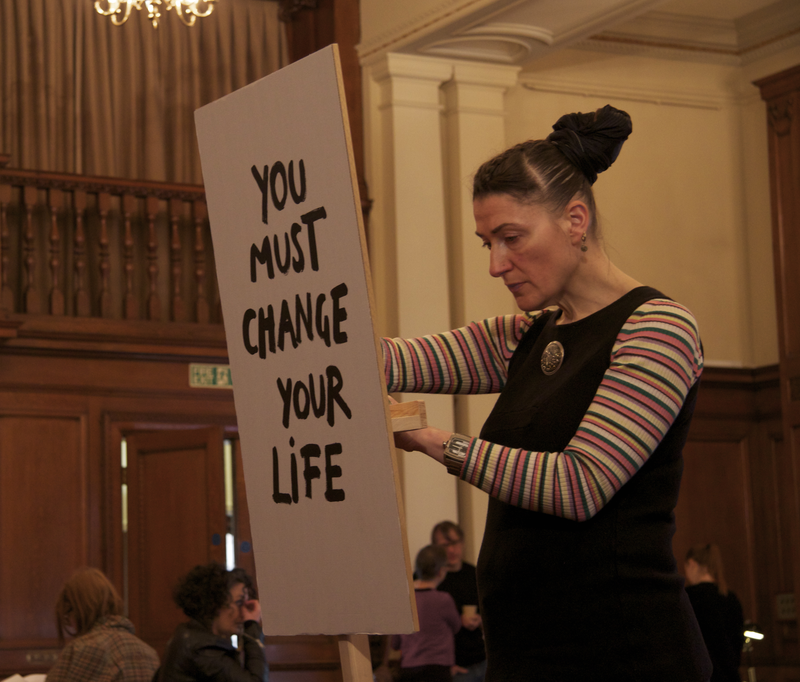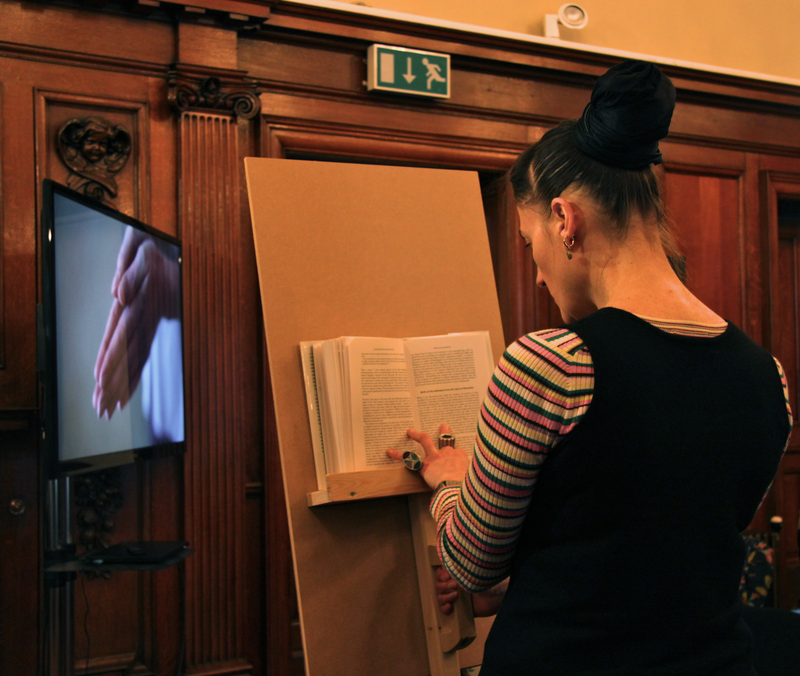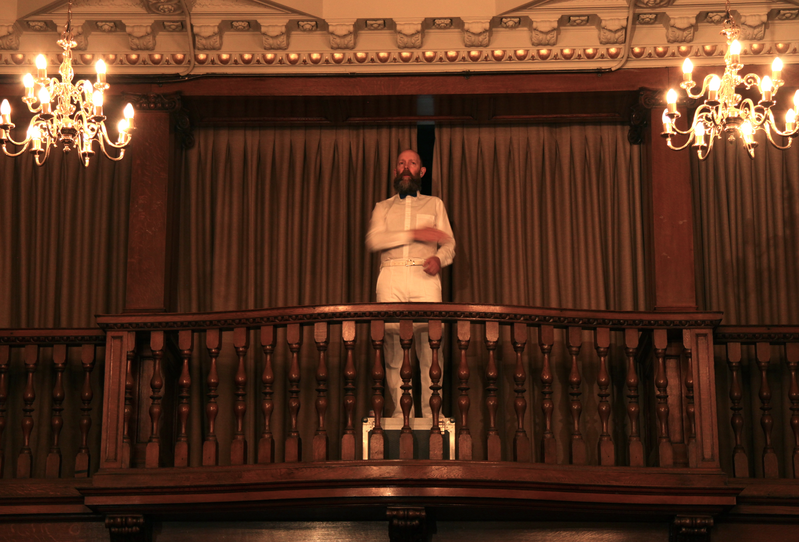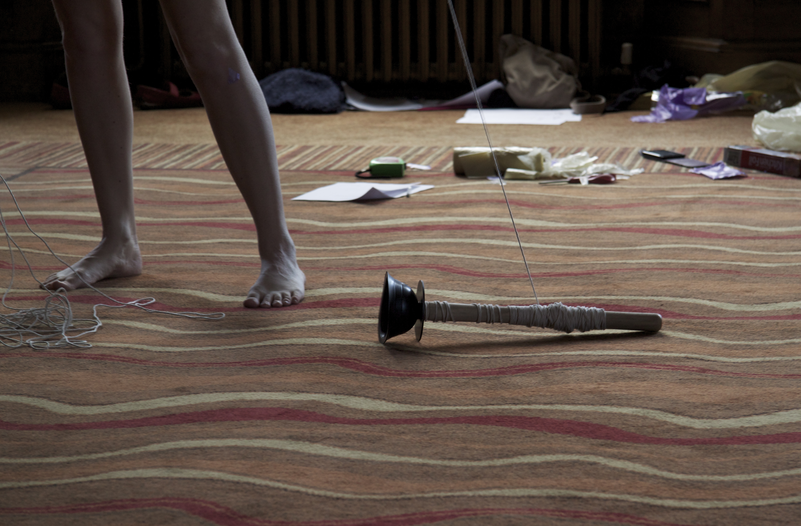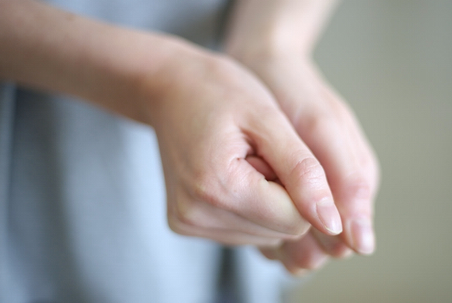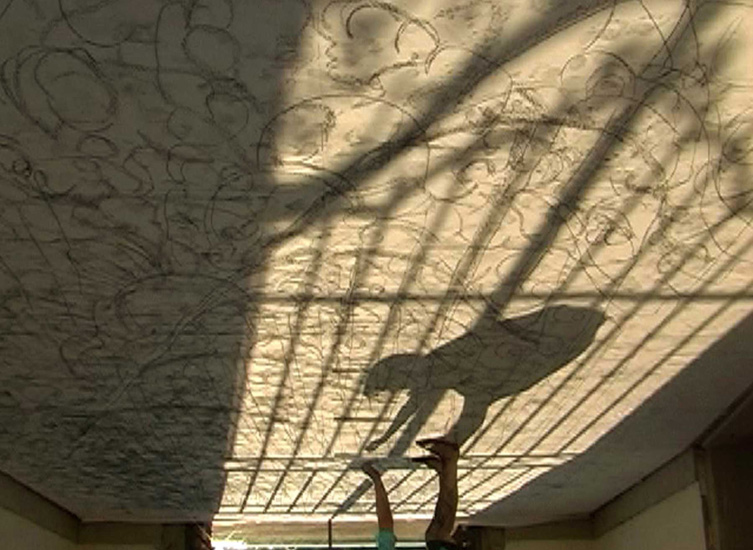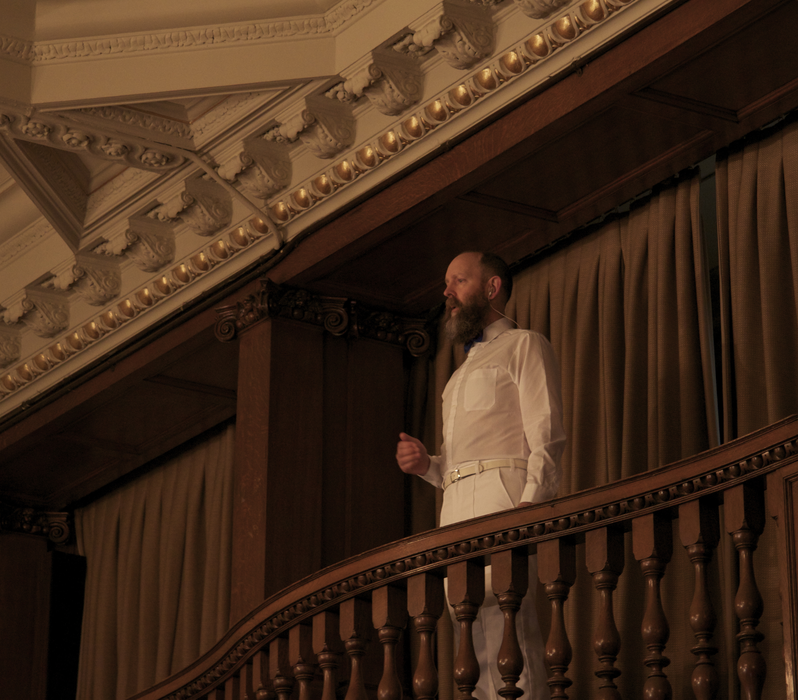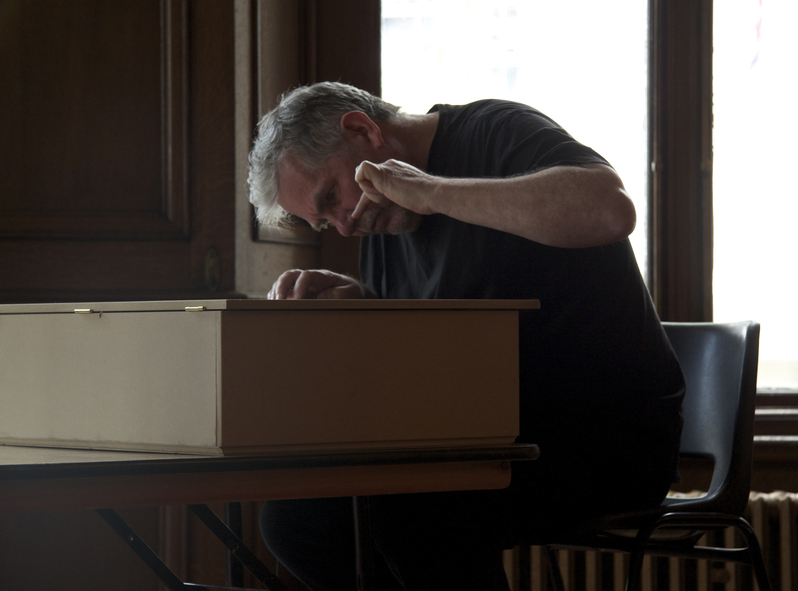Care + Attend
Curated by Emma Cocker + Joanne Lee
Contributors include:
Kate Briggs
Daniela Cascella
Emma Cocker
Steve Dutton + Neil Webb
Mark Leahy
Joanne Lee
Martin Lewis
Sarat Maharaj
Brigid McLeer
Hester Reeve
Lisa Watts
The Plural Present: Artists Research Unconditional Love: A response to by Himali Singh Soin
In Six Memos for the Next Millennium, Italo Calvino illustrates, with the aid of an Italian folktale, how love might be a force of attraction that holds the very craft of a story that brings seemingly disjunct events together. King Charlemagne, spellbound by a ring, falls in love with whoever possesses it: a young girl, an old man, and finally, a lake. “To hold this chain of events together, there is a verbal link, the word 'love' or 'passion,' which establishes a continuity between different forms of attraction. There is also a narrative link, the magic ring that establishes a logical relationship of cause and effect between the various episodes.”
At the Society for Artistic Research’s Spring Event of performance lectures at the Chelsea College of Arts, London, a theme of "Unconditional Love" held the varied sequence of essays together, featuring artists and theorists across time, geography, and disciplines. In a time when the apocalypse is always around the corner and dystopian futures are the only speculation, this seminar felt like the wind blowing suddenly in the opposite direction. And yet the love spoken about was not a rapturously romantic one, nor one of amorous delusion or blind bathos. The performances curated by Emma Cocker and Joanne Lee spanned from the personal to the political to the perpendicular and the peripheral. So precisely planned was the segment that the title itself bore immense weight. In Care + Attend, care harks back to its etymology, curate, and attend, to wait. Barthes, a philosopher to whom the curators refer, said that “a lover is the one that waits.” In the intervals of expectation, we, the audience, flit between being curators and attenders of that which we experience. The visual “+” invites the audience to treat their subjects with almost medical care and attention. Situated around the banquet hall of the Chelsea College of the Arts, the corniced high ceilings and low-lit chandeliers imposed a regal air, imbuing the performances with the particular irony elicited through the fission of tectonic time periods. It was precisely in this coincidence—or gap—between real time, archaic time, and duration that is experiential time, that the performers + audience revelled in.
We ask - how does care and attention manifest within artistic research and art-as-research, moreover, how might artistic research help cultivate a capacity to care and attend. How might we care and attend to the exposition of artistic research, to the specificity of thinking-in-and-through artistic practice.
We ask: can the exposition of research take place through generating relations, proximity, even intimacy between difference practices? Can the exposition of enquiry emerge between the lines of one practice and another; the co-production of meaning or sense-making no longer owned or determined by any one but rather arising as a shared event.
In the catalogue, each artist’s piece is described alongside its duration. Time and the structural intricacies of Cocker and Lee’s curation almost overwhelm the individual pieces themselves, so much so that the whole event becomes a single installation, collapsing the three hours that had both elapsed and contracted. The curators’ introduction was a proposition to both attend to concentration and to distraction—reflecting the hysterical lovers’ psyche—so that we swiveled between a lecture at the main stage, videos on our sides, upstairs on the balcony and behind, everywhere, sound in the distance and a sliver of light allowing a glimmer of a moving body.
The curators were well aware of this “We were also thinking about the writing of Hannah Arendt and Hélene Cixous, both of whom advocate the necessity of withdrawal, a temporary turning of attention away from the stimulus of the world in order to attend more closely, indeed to think. In the perpetual decision-making or the resigned soft focus, we become participants in a “frantic epistemology.”
The three videos—by Victoria Gray, Martin Lewis, and Brigid McLeer—depict barely discernible movements of the hand, echoing the introduction in which we are invited to pursue the infra-ordinary, the detail, wallow in the wait of Boredom. In sharp contrast, a piece by Joanne Lee, Surface Attention, sped things up. A whirl of words, flashing so fast, send signals up your spine as you become aware that in the desperate grasping for a sentence, you have experienced what it is like to fall in unrequited love.
Mark Leahy stands at the balcony—a kind of Juliet—as we look up in admiration, listening to his words alliterating in association, forming narrative, forming nonsense, forming a net of wistful longing.
Care + Attend was an event curated by Emma Cocker and Joanne Lee as part of the Society of Artistic Research Spring event, Unconditional Love, taking place at Chelsea College of Arts, 30 April – 2 April 2015. This exposition will attempt to archive fragments from this event, as well as reflecting further on how notions of care and attention might contribute to debates on artistic research and its exposition.
We – Emma Cocker and Joanne Lee – here offer a few words of introduction, to contextualize our curated event, Care + Attend in relation to the wider context of the provocation Unconditional Love. The title Unconditional Love was indeed a provocation – inviting us to consider how the conditional as well as the unconditional might impact on artistic research; inviting the question ‘what are the conditions for artistic research and what place might ‘love’ have therein’. Often taken for a blind love or faith, unconditional love might rather describe a love without conditions, closer perhaps to a kind of altruism, the bond of comradeship, of a commitment made. The notion of unconditional love might relate to the idea of vocation or of calling, or even the labour of love. Yet, how might the principle of unconditional love operate within the field of academic research where the emphasis seems increasingly on the cultivation of competition perhaps at the expense of collegiality, focused on one’s individual contribution to knowledge, originality and distinctiveness from others, rather than on principles of solidarity and sharing of practice. Indeed, how does a love that is unconditional face up to the demands of rigour and significance; how does it demonstrate impact when it expects nothing back in return?
However, our response is perhaps closer to advocacy than critique. Beginning with the observation that both curate and curiosity have shared etymology in the term ‘care’, Care + Attend seeks to develop a research vocabulary based on receptivity, openness, fidelity, integrity, intimacy, friendship and commitment (whilst not ignoring the parallel principles of distraction, inattention, the act of closing one’s eyes or of looking away). Our session explores the theme Unconditional Love through the principles (perhaps even methodologies) of care and attention, as applied within specific (artistic) practices of both the everyday and of the self. In conceiving the event Care + Attend, we have reflected on different histories and practices, including art and artistic research as well as wider disciplinary fields.
We have thought how Roland Barthes, Georges Perec and Michel de Certeau paid transformative attention to the minutiae of everyday life, and how their methods resonated with our experience of artistic research. From Barthes, we noted his description of the lover as a ‘frantic epistemologist’, someone who attends to clues and signs precisely because they matter so much, and recognised how a cool professional distance cannot be maintained to a loved subject. From Perec’s pursuit of the infraordinary we heeded his call for us to look to ourselves rather than pillaging others – to see the endotic rather than the exotic – and his assertion that the fragmentary, trivial and futile are just as essential as any other method for trying to lay hold of truth. (For Michael Sheringham, Perec’s ‘deviation into practice’ causes temporary but effective suspensions of judgement, where spaces are opened in order to ‘see what happens’, and where research is unlikely ‘to be achieved in a set way, being something with a ‘less defined, more hypothetical’ sense of an end point.) And from de Certeau, the improvisation and resistance of a tactical approach offered us a way to negotiate and navigate the often-problematic demands of a larger institutional and academic framework.
In parallel, we brought to mind Henri Bergson’s work on duration and attention, reframed by Gilles Deleuze as ‘creative attention’, a productive gap or hesitancy emerging through a delay in motor response, the logic of stimulus and response temporarily stalled. Or else, Michel Foucault’s late work on the production of subjectivity and ‘care of the self’ within Ancient Greece culture, the folding of attention back towards the making of ‘life into a work of art’. Or even Baruch Spinoza’s Ethics - his guide for cultivating the capacity to both affect and be affected. Our theme Care + Attend, might be considered against the context of what has been described as an ‘affective turn’ within contemporary theory and practice – from Michael Hardt’s writing on affective labour, to ‘non-representational theory’, to Brian Massumi’s ‘Parables for the Virtual’ or Erin Manning’s Relationscapes – its emphasis on attending to the pre-perceptual, the incipiency of movement. Or else, our ‘theme’ could be conceived through the prism of Eastern philosophy – reflecting the relation between wisdom/knowing and the dual practices of mindfulness (attention) and compassion (care). We were also thinking about the writing of Hannah Arendt and Hélene Cixous, both of whom advocate the necessity of withdrawal, a temporary turning of attention away from the stimulus of the world in order to attend more closely, indeed to think.
It was with these ideas swirling in mind that we invited our guests - Kate Briggs, Daniela Cascella, Belén Cerezo, Steve Dutton + Neil Webb, Victoria Gray, Rob Flint, Mark Leahy, Martin Lewis, Sarat Maharaj, Brigid McLeer, Hester Reeve, and Lisa Watts. Attending to their abstracts, other connections and relations emerge. Practices of and for reading, listening, attending to the unfolding of an activity, or the passing of time. Practices based on the tact, tactics and tactility of handling, on the delicate art of translation, gestures towards communication. Practices that push or pressure attention, stretching its limits, testing its range. Whilst the terms care and attention might suggest a quality of focus, commitment and precision even, within the context of artistic research care and attend also intimates towards the need for receptivity and openness – to the unknown or imperceptible, to the incoherent or opaque, to the marginal or peripheral. Here arguably, no singular model of care and attention emerges: surface is valued alongside depth, glimpsing alongside extended forms of encounter, the quick alongside the slow. We ask: how does care and attention manifest within artistic research, moreover, how might artistic research help cultivate a capacity to care and attend. How might we care and attend to the exposition of artistic research, to the specificity of thinking-in-and-through artistic practice.
Care + Attend comprises a constellation of fragments and extracts - of different intensities and durations - where the exposition of research emerges as a poetic and performative event, generating moments of potential resonance and dialogue. We ask: can the exposition of research take place through generating relations, proximity, even intimacy between difference practices? Can the exposition of enquiry emerge between the lines of one practice and another; the co-production of meaning or sense-making no longer owned or determined by any one but rather arising as a shared event. Care + Attend unfolded over a 3-hour period: at times the invitation to the audience was to sit, to listen and to watch, attending to a spoken presentation or a film screened. At other times, the invitation to the audience was to move, to wander and to encounter performances and actions happening throughout the space. At times, there was an invitation to browse publications and printed matter brought to the event by contributors, at other times, the audience was invited to contribute to the event in the shared reading of a text. The invitation was towards a quality of present-ness, an invitation to attend for the duration, to be moved by the different unfolding energies and intensities, receptive to the different relations and connections between diverse practices as they are brought into temporal and spatial proximity.
Whilst it is not possible to replicate the experience of this event – the overlapping and contingent forms of sense-making unfolding in a particular space, at a particular time – nonetheless we attempt to share some of the intent (in the form of contributors' abstracts) and some documentation from the event. Our event was something of an experiment in 'exposition', and indeed has given us much to think about in relation to the thresholds and grey areas between artistic practice and research, between artistic and other forms of research practice, between individual and collective expositions of research enquiry ... not to mention the relation between the production of knowledges and non-knowledges therein.
Along similar lines of lilting prose was Emma Cocker’s Close Reading, in which time dilates in “microscopic observation,” as she attends to her own language with such care that it magnifies every word, often minimizing meaning. Perhaps words that alliterate are a kind of anthropomorphic intimacy. They pick up each others’ mannerisms, they make music even when they’re mute, they are simultaneously affectionate and elusive: “…language is not only to be looked at for its sense; consider the attendance of the other senses. Certain language must be rolled in the mouth before it can be fully digested. Words are sonorous as much as signifying units; the soundness of a text tested—even tasted—by tongue and lips as much as by the mind. Care for the curve and bend of every letter of every word. Linger longer over every phoneme. Recall the “part that breath plays in verse”. Practice the plosive pleasure of the p or fricative f … f … f. Become sensitized to the sibilant s … s”. All the while Hester Reeve carries a book on an easel, reading at different points in space.
I think of love, often, as a kind of plural present. The kind of attention required in this piece, and the care with which it was delivered, forced the audience into a kind of removed presentness. The invitation was towards a "quality of present-ness, an invitation to attend for the duration, to be moved by the different unfolding energies and intensities, receptive to the different relations and connections between diverse practices as they are brought into temporal and spatial proximity".
Conceived as a durational series of miniature performances for the hands, Berthing Bone (2014) explores incipient action; the affective experience of movement before movement takes form. Through corporeal and moving-image based strategies of stillness, slowness and close proximity, the work advocates heightened modes of attention to micromovements at the borders of consciousness, occurring in moments of hesitation. In turn, somatic modes of attention are proposed as an activist practice; a 'quiet theory of loud mobilization' (Sloterdijk, 2008). Berthing Bone was filmed at Yorkshire Sculpture Park, Longside Gallery, Wakefield. Performance and direction by Victoria Gray. Camera and post-production by Orillo. Funded by Arts Council England through the National Lottery. Supported by Yorkshire Sculpture Park and the Arts Council Collection. An excerpt of the video can be viewed here.
‘flat-head self-tapping’ engages with speaking in public, with being on show, with being heard, and with displaying coded behaviour. Taking elements from Bell’s Standard Elocutionist and from online dictionaries, the performance assembles fragments, word lists, letters, and gestures into a display of awkward flapping interrupted by gnomic expulsions. The performer receives instructions, phrases, or data via headphones and then repeats these verbally and with gestures to the audience. As the material is delivered randomly to the performer, he (like the audience) doesn’t know what’s coming next.
Lisa Watts
Hairbrained, Studio Activity Sheets + 32 Significant Moments: an artist’s practice as research (performed action over 3 hours)
Care + Attend comprised a series of durational actions, video works + performances (see below for details).
This durational video work was made while on residency at San Servolo Island, Venice, Italy in 2007. San Servolo was the former psychiatric hospital for the Veneto Region until it was closed in the 1970s. The work is often accompanied by the drawing produced (as seen in the video), which is 7.5m x 5m. An excerpt of the video can be viewed here.
This current series of drawings, of which this is the fourth rehearsal, are attempts to encounter profound boredom, and what may be experienced during these attempts. The drawings enact banal, repetitive and durational tasks, using sound as its material and the site as its ground. Perpetual Rehearsals are a series of performance drawings whereby any completion of the work is unresolvable or unattainable. The work is in a continuing state of incompletion. Because of its unwillingness, reluctance and under-preparedness to reach a satisfactory ending the work can never be staged as a fully formed event.
Hester Reeve
Attendez: I care and attend to the book and the book cares and attends to the we in me. (performed action over 3 hours)
This action embodies and makes explicit a pivotal research methodology in my practice as an artist: reading philosophy. Reading philosophy is not a straight-forward matter of gaining knowledge, instead it affects a capacity to craft thinking as a type of matter for art making. Simultaneously, reading certain philosophical texts addresses the self as a dynamic potential with a capacity to be ‘carved’ from without. This is not self-indulgence, caring after the techne of being a ‘me’ is always on behalf of the ‘we.’ On a more prosaic level, this action reflects my concern to create through manifestation and not communication and my use of the visual motif of public protest, a placard, to protect notions of experimental practices of existence and transformation. The book I am currently reading and affected by is You must change your life! By Peter Sloterdijk.
This research focuses upon the messiness found in the middle of making. Whilst most dialogues concerned with artistic processing derives from artists interviewed once the disorderliness and the blankness is over, Hairbrained in contrast, offers a view of the intensity, care and attention of the working artist and their solo thoughts. Studio Activity Sheets, created by the artist, provide a close-up diary of detailed thoughts, actions, revelations and accidents, along with notes for future action, lists, memory jogs and questions… They were used to develop the book 32 Significant Moments: an artist’s practice as research.
The event also unfolded through a series of spoken word and visual presentations (details below in sequential order).
Rob Flint
on the road to your house
... your house
is a blessing and a curse...
...your house
is a figure of speech
on the road to your house is part of a series of works in which the declarative voice is explored through ideas of ‘faciality’. The ‘face’ is here understood as an intense and condensed signification, pointing toward it’s own meaningfulness as an event in unison. The work borrows from chorus traditions, theatrical and religious, and magical ideas of enchantment, as well from a lingering cultural need, beyond flickering lit screens, for things to be spoken in order to become law. Our care and attention is still called for by faces and voices.
Kate Briggs
On Translation and Table-Making
On Translation and Table-Making is the title of a book-in-progress on the work of translation: its rhythms and conditions, its modes of learning and unlearning, the forms of its attention, its particular articulation of the activities of reading, writing and making. In this presentation Briggs read from different sections of the book, re-sequencing them in a way that attends to themes of the session and foregrounds her experience of translating some of Roland Barthes’s late work.
This enquiry reframes the practice of close reading as a resolutely visual method, a critical tactic for destabilizing and fragmenting the linear unfolding of text towards an experimental poetics. Within Close Reading, care and attention is not paid to the sense of words at the level of signification, but rather to the affective and asignifying register of meaning produced by attending to the materiality and movement of words ‘close up’ through processes of visual magnification, microscopic observation. Here, paying close attention to language does not always clarify any single, stable meaning, but perhaps counter-intuitively produces further indeterminacy and incoherence, where the closer something is scrutinised the less it becomes known.
Daniela Cascella
‘The attention dwells on the peripheral…’
Cascella presented texts generated by a ‘listening into writing/reading into writing’ methodology that she has been using while writing her new book, F.M.R.L. Footnotes, Mirages, Refrains and Leftovers of Writing Sound. It allows for accidents, detours of thoughtsrather than any assumed core, up to the point when the very core of listening-reading-into-writing becomes what is normally deemed peripheral. Cascella seeks to reclaim the intermittent incoherence in listening and reading, and to move through their residual presence into a marginated writing that is edge, horizon, fuga.
Steve Dutton + Neil Webb
End of Ends
End of Ends is an ongoing project which sits in the background of our daily work. Indeed, its situation as a form of backdrop is a critical part of its make-up. The project is an invitation to think and work with a sense of ending. The production of endings, the gathering of them and ‘showing’ them becomes a form of soft labour. Perhaps like Arakawa and Gins’ philosophical play on their decision ‘not to die’, the very production of the list is a confirmation that the list cannot itself ever end, and thus, ‘we’ too, will not die. View work here.
How to Open my Eyes? exposes the importance of attending to the materiality of photographs through handling them. It does this through performing different photographic materials (old photographic papers that have never been used, a book that misses one photograph, Google Earth and black and white photographic film). Hence, this research/work makes evident a form of ‘affective encountering’ with images, which stems from touching them. In regard to artistic research, this research/work sheds light on a methodology that stems from thinking with images in a poetic, speculative and essayistic way. First presented as a performance-lecture during the Summer Lodge, Nottingham Trent University, 2012.
Sarat Maharaj
‘Ignorantitis Sapiens’: A Trolls View
What forces and factors attend the transmutation of London – today’s skyline of cranes – from a post-colonial city into a post-imperial, global realm? Why are we bovvered? A process of mapping the emerging ‘designs for living’ of the ‘new urbanity’ from my kitchen and rooftop labs. They overlook the demolition/construction sites in my patch of London – the ‘Knowledge Mecca’ of Bloomsbury. A glance at the clamber up and down the ladder of attentiveness – of enlightenment (Buddhi) and ignorance / foolishness (Buddhu)?
Joanne Lee
Surface Attention
Surface Attention presents a photographic series developed during a research residency at the former Spode Works in Stoke-on-Trent, UK; this 10-acre site was acquired by Josiah Spode l in 1776 and ceramic wares were made there until the company’s bankruptcy in 2008. The project’s methodology takes up historian Joseph Amato’s suggestion that we ought ‘to concentrate on surfaces’, and pursues the close rather than deep reading advocated by Caroline Levine. Surface Attention is a form of quiet, curious and repeated looking... Elements of this work appear in Pam Flett Press #4 Vague terrain.
Bio-notes
Kate Briggs is a writer and translator based in Paris. She is the translator of Roland Barthes’s How to Live Together (2013)and The Preparation of the Novel (2011), both published by Columbia University Press. Other publications include: Exercise in Pathetic Criticism (2011) and The Nabokov Paper (2013), both published by information as material, and ‘Small Hand (a paper-size poem)’ in Convolution: A Journal of Conceptual Criticism. She has new work forthcoming in L’esprit créateur (on practicing with Roland Barthes) and downloadable from the Leeds College of Art Library website (on ‘what we call by the book’s name’). She is a core tutor on the MFA in Fine Art at the Piet Zwart Institute, Rotterdam and also teaches at the American University of Paris.
Daniela Cascella is a London-based Italian writer. Her research is focused on sound and literature across a range of publications and projects, driven by a longstanding interest in the relationship between listening, reading, writing and in the contingent conversations, questions, frictions, kinships that the three practices generate, host or complicate. She is Honorary Research Fellow in the School of Arts, Oxford Brookes University; Writing Tutor in the MA Fine Arts, Bergen Academy of Art and Design; Associate Lecturer in Sound Arts at the University of the Arts London. www.danielacascella.com
Belén Cerezo is an artist-photographer. Within her practice and research, photography operates as the guiding notion. Through a focus on the materiality of images, she explores photography through performance attempting to renovate the discourse on images. Belén Cerezo has just completed a practice-led PhD at Nottingham Trent University where she is an associate lecturer in Photography. She is also interested in art education and she co-coordinated the Education Department for Manifesta 8, Murcia, Spain, 2010. Cerezo published the photo-book Somewhere Better, Nowhere Better in 2009. She had a solo exhibition titled Plastic People at CAB in Burgos, Spain, in 2008.
Emma Cocker is a writer-artist and Reader in Fine Art, Nottingham Trent University. Operating under the title Not Yet There, her research often addresses the endeavour of creative labour, focusing on models of (art) practice and subjectivity that resist the pressure of a stable position, remaining willfully unresolved. Cocker's writing has been published in Failure, 2010; Stillness in a Mobile World, 2010; Drawing a Hypothesis: Figures of Thought, 2011; Hyperdrawing: Beyond the Lines of Contemporary Art, 2012; On Not Knowing: How Artists Think, 2013, and Reading/Feeling, 2013. She is currently a key researcher on the project Choreo-graphic Figures: Deviations from the Line (2014 – 2016). http://not-yet-there.blogspot.com
Steve Dutton is Professor in Contemporary Art Practice at the University of Lincoln. Individual and collaborative projects have been exhibited throughout the UK and internationally, including The Institute of Beasts at Kuando Museum of Fine Art in Taipei and The Stag and Hound at PSL in Leeds UK (both Dutton and Swindells ). His collaboration with Neil Webb for the ‘End of Ends’ project was originally an Arts Council Funded project for Bend in the River in the East Midlands of the UK. He is a committee member of “Project Anywhere, Art at outermost limits of Location Specificity.”
Neil Webb works extensively with sound and his practice includes sound installation, film and live performance. His work often reinterprets elements of film and literature narratives that have included works such as ‘Far Beneath in the Abysmal Sea’ (2009), inspired by Tennyson’s sonnet and John Wyndham’s book ‘The Kraken Wakes’. He has also made work inspired by 2001 A Space Odyssey, titled ‘The Stars In Us All’ (2007). His work has been exhibited internationally and he has undertaken residencies in the UK and abroad. He is Senior Lecturer in Sound Design at Sheffield Hallam University. www.neilwebb.com
Rob Flint is an artist whose work engages with the way sound affects our other senses, especially vision. He often uses the idea of ‘voice’, in spoken, written, and printed form. He is best known for work with Christine Sullivan, with whom he has created a series of works exploring description and voice narration, including The Bill Burroughs Memorial Choir, and Conversation Piece in 'Hlysnan' at Casino Luxembourg, in the City of Luxembourg in summer 2014. Recent solo work includes sound wall composition Flock Mnemonics at The Collection in Lincoln in October 2015.
Victoria Gray is an artist, writer and practice-led researcher. She has presented work in the UK, USA and throughout Europe. Often durational, her performance and video work is concerned with affect and kinesthetic experience, integrating affect theory, process philosophy and somatics. Recent publications include articles in Journal of Dance & Somatic Practice (2012), Choreographic Practices (2013) and The Drama Review (2015), and, chapters in the edited books Kinesthetic Empathy in Creative and Cultural Practices (2012) and forthcoming, Experiencing Live: Liveness, Eventness, Nowness and the Arts (2015). Victoria is a PhD candidate at Chelsea College of Art & Design, University of the Arts, London. www.victoriagray.co.uk
Mark Leahy is a writer, artist, and teacher, operating among textual practices, performance, and installed arts. He works with the body as sensing and as affected, using language, models of perception, and objects of everyday use. Including spoken word, task-based actions, and digital operations his performances address the body as a site of inscription and activation. His textual practice utilizes constraints, structuring rules, and operates to cross or question category and genre divisions including around identity and agency. He is based in Devon, and teaches part-time at Falmouth and in Plymouth Universities. www.markleahy.net
Joanne Lee is an artist, writer and publisher whose research attends to everyday life and the ordinary places in which she lives and works. Much of her activity emerges through a serial publication, the Pam Flett Press, which explores the visual, verbal and temporal possibilities of the ‘essay’, and via the opportunities for production that arise in dialogue with creative and critical friends. She is Senior Lecturer in Fine Art at Nottingham Trent University and Associate Lecturer in Graphic Design at Sheffield Hallam University. www.joannelee.info
Martin Lewis a Nottingham based artist and teacher. He has been engaged in a drawing practice since 2009. Lewis’s focus is on the act of drawing, paying attention to the mutations and deviations that occur during the transition between the cognitive and the somatic. His recent exhibitions include: Drawology (Part1, Bonnington Gallery Nottingham. Part 2, Lanchester Gallery, Coventry). Alignment, at Backlit Gallery, Nottingham and Insisting Over Skin, Drawing After Surface with Robert Luzar at the Kingsgate Gallery London.
Sarat Maharaj is Professor of Visual Art and Knowledge Systems, Malmo Art Academy/Lund University and Research Professor, Goldsmiths’ University of London where he was History/Theory of Art Professor (1980 – 2005). He was Rudolf Arnheim Professor, Humboldt University, Berlin (2001 – 02). He was co-curator of Documenta XI, 2002, ‘Farewell to Postcolonialism’, Guangzhou (2008) and the 29th Sao Paolo Biennial, 2010. He was chief curator of ‘Pandemonium – art in a time of creativity fever’, Göteborg, 2011. His specialist publications cover Marcel Duchamp, James Joyce and Richard Hamilton, visual art as non-knowledge and no-how, textiles, globalization and cultural translation.
Brigid Mc Leer is an Irish artist based in London. She trained in Fine Art at NCAD, Dublin, University of Ulster, Belfast and Slade School of Art, London. She works in various media/modes including video, durational performance, photography, and drawing/writing. Recent solo exhibitions include ‘One + One’, at Highlanes Gallery, Drogheda and Wexford Arts Centre, Ireland, ‘Horizontal Ontologies’ Art Currents Institute, New York, Isoli [cont.], Lanchester Gallery Projects, Coventry, and ‘Vexations’, Site Gallery Sheffield, UK. She is currently studying for a PhD by project in Fine Art (Photography) at the Royal College of Art, London. www.brigidmcleer.com
Hester Reeve explores art as a species of philosophical agency, invested first and foremost in the task of thinking and thinking’s relationship to the body and matter at large. Working with action, writing, sculpture, drawing and Bohmian Dialogue, she chooses to operate via ‘HRH.the’ (a conceptual persona), an intellectual and fantastical strategy by which she navigates her complex relationship to the world. Recent venues showing her work include Yorkshire Sculpture Park, Tanzquartier Vienna and Tate Britain (under the umbrella ‘The Emily Davison Lodge,’ an on-going collaboration with Olivia Plender). Reeve is Senior Lecturer in Fine Art at Sheffield Hallam University.
Dr Lisa Watts is an artist with an eclectic practice of performance, sculpture, photography and video. Recent projects have included Skittish, a UK touring gallery exhibition for Spacex, Vane and The Tetley, which exhibited Watts’ live work together with other artists’ sculptures that culminated in a symposium, Puff of Smoke: curating live art/performance in the gallery (2014). A documentary about her facilitation/ visual art methods has been recently launched, for the AHRC Birthproject, titled, Mothers Make Art (2015). Her book 32 Significant Moments: An Artist's Practice as Research (2014) presents a close-up, detailed view of some of her artistic processes.
